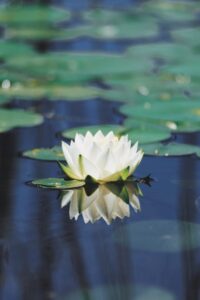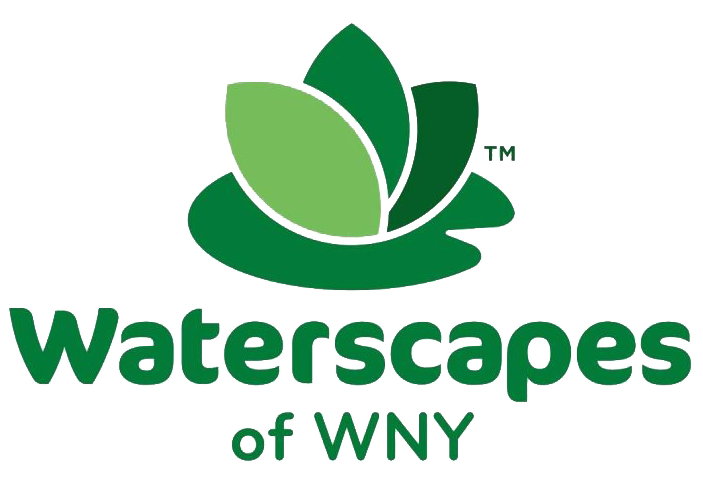
You have thought long and hard about where the best place for your water feature would be. You have decided a (fountainscape, pondless waterfall, ecosystem pond) would be best suited right off your back patio. There is plenty of space for a large feature, a berm behind it, and still room to walk around the it. Now, its time to design the feature.
When you close your eyes what does your perfect feature look like? Is it tall and loud or low and soft? Are the rocks you used to build this feature round boulders found locally? Are they angular weathered limestone? Does your feature have river rock on the bottom or a Mexican smooth stone? ARE THERE PLANTS?
Of course there are plants! Plants are essential!
When designing a feature it is key to plan for both aquatic and landscape plantings. It can be difficult to add aquatic plants to a fountainscape, but not impossible. These plants would have to love water and have small shallow roots (as to not become invasive in the basin of the fountain). It is easier to add landscape plantings as close to the edge of the “rock” area of your fountainscape. Consider the amount of splash your feature will have and plant accordingly. I prefer to add low lying plants and ground cover in front of the fountain and put the taller plants in behind as a backdrop. If the fountain can be seen from all sides, keep all of the plants low.
Pondless waterfalls also require a bit more planning when it comes to aquatic plants. The best place to add these aquatics would be in the small pooling areas of the waterfalls. Consider though that when the waterfalls are off (vacation, power outage, timer off at night, etc) these pools of water can slowly drain out therefore leaving your roots dry for X amount of time. If you keep your water running all Spring, Summer, and Fall these pooling areas are a great place for tropical plants. Again, landscape plantings are perfect for pondless waterfalls. The way waterfalls are constructed there are perfect pocket areas just outside the waterfall rocks to add “creeping” plants. Keep the low lying plants next to the waterfalls and the tall plantings behind it. You do not want to obstruct your view of your feature, but you do want everything around it to “disappear”.
Ecosystem Ponds are by far the easiest water feature to plant. There are countless opportunities to add color inside the body of the pond and along the edge of the outside. Even beyond the edge of the pond and into the landscape itself is important to plan out. When constructing a pond, consider the depths that plants like to be at (18″ +/- for lilies and 8″+/- for iris and most marginals). Add planting shelves within the pond, but don’t block your viewing area. Put these planting shelves to the sides and back of the pond so that when you are sitting on your deck looking at the waterfalls these aquatic plants “frame” the waterfalls not obscure it.
Our goal when planting aquatic plants within a feature and landscape plantings outside a feature is to blur the line between where the water feature ends and the landscape starts. We want it to look as though the water feature was already there and that the house, deck, or patio was built around it. The way we do that is to incorporate plants to re-create nature.
Imagine you just finished building your fountainscape. You have a bubbling rock in the middle, surrounded by a perfect circle of river rock and then your original mulch and plantings. You just finished your pondless waterfalls and you used weather limestone to cover the basin and construct your waterfalls. You didn’t know what to do with the area around the feature so you just added mulch. You just finished your ecosystem pond using round boulders and Mexican smooth stone. Outside of the feature you wanted to limit your maintenance so you added a landscape bed using river rock (instead of mulch). All you see is rock. Where are the plants?
Now picture this, your ecosystem pond has two healthy lilies in the bottom with two hardy iris on either side of the waterfalls and assorted tropical plants in the waterfalls and body of the pond. Right against the boulders are ground cover “creeping plants” that drape into the pond hiding half the boulders. Next to the waterfalls you have a Japanese maple tree with a branch that perfectly hovers above one of your waterfalls. This is where the birds like to perch before moving their way into the stream-bed. Your pondless waterfalls not only has mulch but also numerous ground-covers, bushes, and trees. Your fountainscape is hidden amongst a sea of annual and perennial plantings.
What is the difference? Plants!
KEY TAKEAWAY – You don’t want your water feature to seem like an afterthought. Although it may be the latest addition to your landscape it shouldn’t stick out…. but rather blend in. Plants are the key to perfecting the “blend”.

Leave a Reply